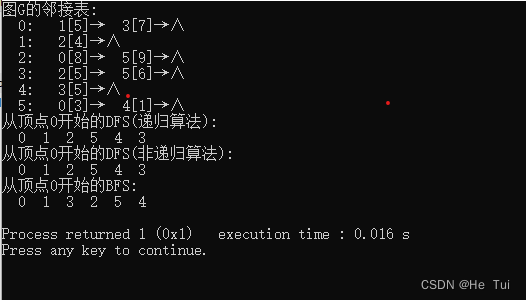#include <stdio.h>
#include <malloc.h>
#define INF 32767
#define MAXV 100
typedef char InfoType;
typedef struct
{ int no;
InfoType info;
} VertexType;
typedef struct
{ int edges[MAXV][MAXV];
int n,e;
VertexType vexs[MAXV];
} MatGraph;
typedef struct ANode
{ int adjvex;
struct ANode *nextarc;
int weight;
} ArcNode;
typedef struct Vnode
{ InfoType info;
int count;
ArcNode *firstarc;
} VNode;
typedef struct
{ VNode adjlist[MAXV];
int n,e;
} AdjGraph;
void CreateMat(MatGraph &g,int A[MAXV][MAXV],int n,int e)
{
int i,j;
g.n=n; g.e=e;
for (i=0;i<g.n;i++)
for (j=0;j<g.n;j++)
g.edges[i][j]=A[i][j];
}
void DispMat(MatGraph g)
{
int i,j;
for (i=0;i<g.n;i++)
{
for (j=0;j<g.n;j++)
if (g.edges[i][j]!=INF)
printf("%4d",g.edges[i][j]);
else
printf("%4s","∞");
printf("\n");
}
}
void CreateAdj(AdjGraph *&G,int A[MAXV][MAXV],int n,int e)
{
int i,j;
ArcNode *p;
G=(AdjGraph *)malloc(sizeof(AdjGraph));
for (i=0;i<n;i++)
G->adjlist[i].firstarc=NULL;
for (i=0;i<n;i++)
for (j=n-1;j>=0;j--)
if (A[i][j]!=0 && A[i][j]!=INF)
{ p=(ArcNode *)malloc(sizeof(ArcNode));
p->adjvex=j;
p->weight=A[i][j];
p->nextarc=G->adjlist[i].firstarc;
G->adjlist[i].firstarc=p;
}
G->n=n; G->e=n;
}
void DispAdj(AdjGraph *G)
{
ArcNode *p;
for (int i=0;i<G->n;i++)
{
p=G->adjlist[i].firstarc;
printf("%3d: ",i);
while (p!=NULL)
{
printf("%3d[%d]→",p->adjvex,p->weight);
p=p->nextarc;
}
printf("∧\n");
}
}
void DestroyAdj(AdjGraph *&G)
{
ArcNode *pre,*p;
for (int i=0;i<G->n;i++)
{ pre=G->adjlist[i].firstarc;
if (pre!=NULL)
{ p=pre->nextarc;
while (p!=NULL)
{ free(pre);
pre=p; p=p->nextarc;
}
free(pre);
}
}
free(G);
}
int visited[MAXV];
void DFS(AdjGraph *G,int v)
{
ArcNode *p;
visited[v]=1;
printf("%3d",v);
p=G->adjlist[v].firstarc;
while (p!=NULL)
{
if (visited[p->adjvex]==0)
DFS(G,p->adjvex);
p=p->nextarc;
}
}
void DFS1(AdjGraph *G,int v)
{
ArcNode *p;
int St[MAXV];
int top=-1,w,x,i;
for (i=0;i<G->n;i++)
visited[i]=0;
printf("%3d",v);
visited[v]=1;
top++; St[top]=v;
while (top>-1)
{
x=St[top];
p=G->adjlist[x].firstarc;
while (p!=NULL)
{
w=p->adjvex;
if (visited[w]==0)
{
printf("%3d",w);
visited[w]=1;
top++;
St[top]=w;
break;
}
p=p->nextarc;
}
if (p==NULL) top--;
}
printf("\n");
}
void BFS(AdjGraph *G,int v)
{
ArcNode *p;
int queue[MAXV],front=0,rear=0;
int visited[MAXV];
int w,i;
for (i=0;i<G->n;i++) visited[i]=0;
printf("%3d",v);
visited[v]=1;
rear=(rear+1)%MAXV;
queue[rear]=v;
while (front!=rear)
{
front=(front+1)%MAXV;
w=queue[front];
p=G->adjlist[w].firstarc;
while (p!=NULL)
{
if (visited[p->adjvex]==0)
{
printf("%3d",p->adjvex);
visited[p->adjvex]=1;
rear=(rear+1)%MAXV;
queue[rear]=p->adjvex;
}
p=p->nextarc;
}
}
printf("\n");
}
int main()
{
AdjGraph *G;
int A[MAXV][MAXV]={
{0,5,INF,7,INF,INF},
{INF,0,4,INF,INF,INF},
{8,INF,0,INF,INF,9},
{INF,INF,5,0,INF,6},
{INF,INF,INF,5,0,INF},
{3,INF,INF,INF,1,0}};
int n=6,e=10; //图8.1中的数据
CreateAdj(G,A,n,e);
printf("图G的邻接表:\n"); DispAdj(G);
printf("从顶点0开始的DFS(递归算法):\n");
DFS(G,0);printf("\n");
printf("从顶点0开始的DFS(非递归算法):\n");
DFS1(G,0);
printf("从顶点0开始的BFS:\n");
BFS(G,0);
DestroyAdj(G);
return 1;
}























 1743
1743











 被折叠的 条评论
为什么被折叠?
被折叠的 条评论
为什么被折叠?








